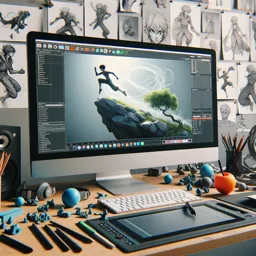Introduction
Lighting is one of the most powerful tools in Blender for bringing depth, mood, and realism to your animated scenes. Whether you’re crafting a cinematic moment, a stylized short, or an explainer video, understanding how to leverage Blender’s robust lighting features will elevate the impact of your video animations. In this article, we’ll explore the essential lighting concepts in Blender and guide you through techniques to enhance your creative projects.
Why Lighting Matters in Animation
Lighting isn’t just about making things visible – it’s about storytelling, too. The right lighting can direct the viewer’s attention, establish atmosphere, and highlight key moments in your animation. Poor lighting, on the other hand, can make even the most detailed models look flat and lifeless.
Blender’s Lighting Tools Overview
Blender offers several types of lights, each serving different needs:
- Point Light: Emits light in all directions from a single point. Ideal for bulbs or candles.
- Sun Light: Simulates sunlight, casting parallel rays. Great for outdoor and broad daylight scenes.
- Spot Light: Projects light in a cone shape, helpful for stage lighting or focused effects.
- Area Light: Provides soft, diffused lighting, excellent for natural and studio-like environments.
- Emission Shader: Makes materials themselves emit light, useful for screens or glowing objects.
Basic Lighting Setups
Setups like the classic three-point lighting system (key, fill, and rim light) are great starting points to create balanced illumination:
- Key Light: The main source that defines your scene’s overall look and feel.
- Fill Light: Softens shadows caused by the key light, reducing contrast.
- Rim Light (Back Light): Adds separation between the subject and background for a more three-dimensional effect.
Advanced Lighting Techniques
- HDRI Lighting: Use image-based lighting to produce realistic environment reflections and lighting.
- Light Linking: Direct which objects a light will affect using the Light Groups feature for more control over complex scenes.
- Volumetric Lighting: Simulate fog or atmosphere for dramatic effects by enabling volumetrics in the render settings.
- Color Temperature: Mimic real-world lighting by adjusting the color and intensity of your virtual lights to suggest different times of day or emotional tones.
Optimization Tips
Lighting can impact your render times significantly. Minimize noise and maximize efficiency by using denoising filters, limiting the number of bounces in your render engine, and leveraging Blender’s Eevee renderer for real-time previews.
Conclusion
Mastering lighting in Blender opens up endless creative opportunities for your video animations. Experiment with different setups, play with colors and shadows, and push the boundaries of your visual storytelling. The more you practice, the more you’ll discover what lighting can do for your art.

















